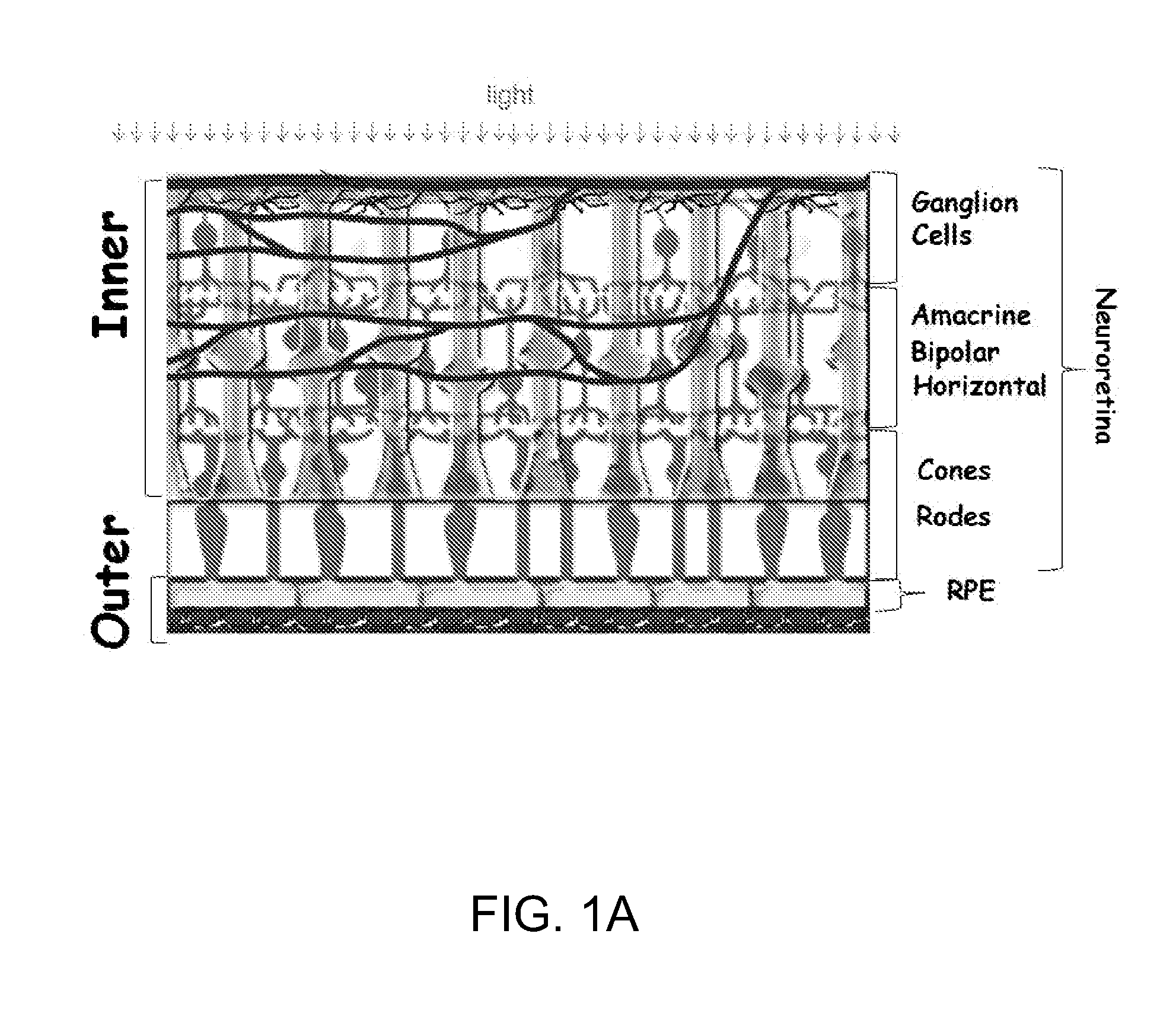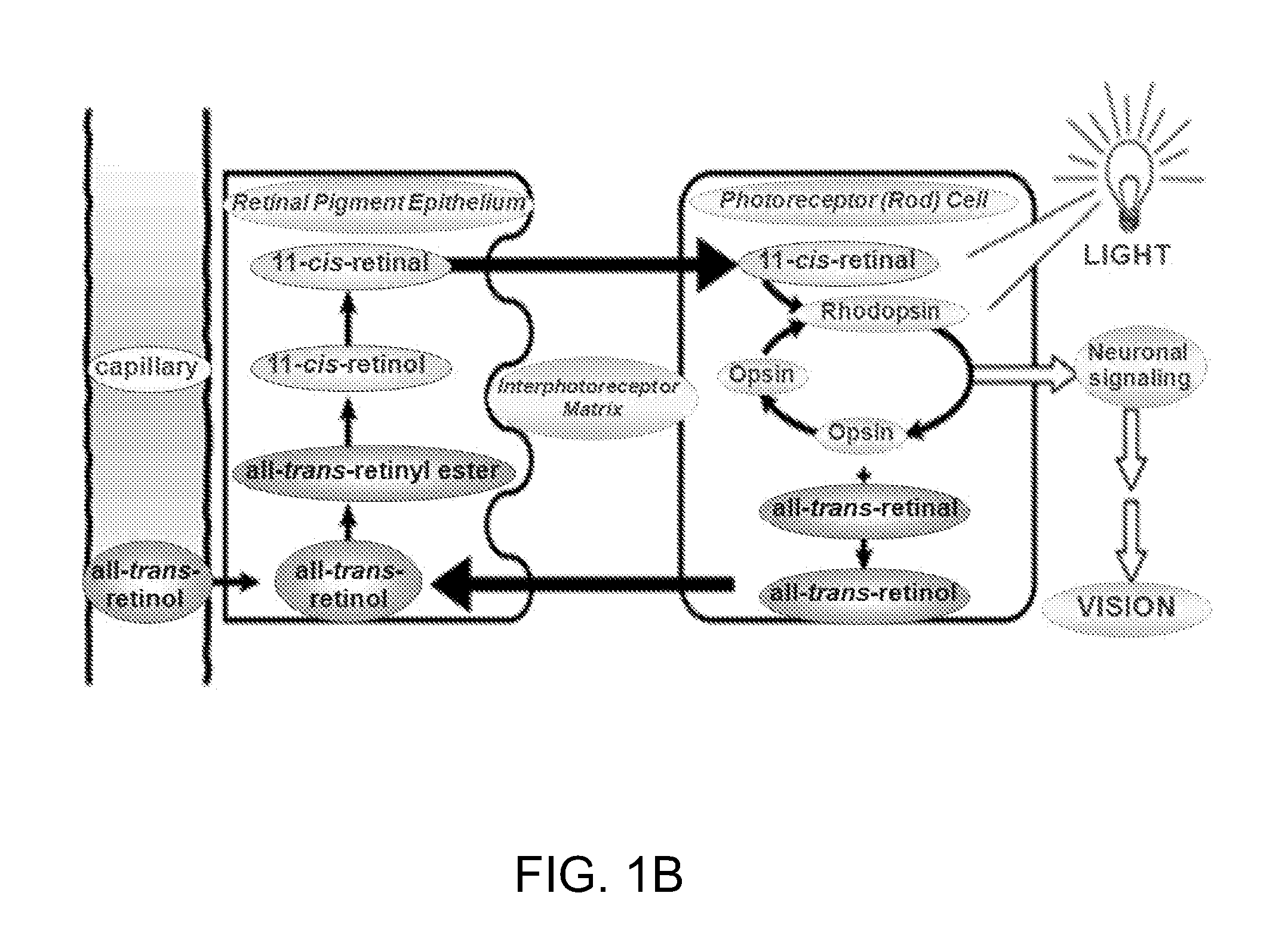Treatments for retinal disorders
a retinal disease and retinal disease technology, applied in the field of retinal diseases and conditions, can solve the problems of affecting the function of the retina, the lipid level of lipofuscin bisretinoid, and the aging of the retina, and achieves the effects of reducing lipofuscin bisretinoid lipid levels, minimal or no disruption of cell vitality, and no toxic
- Summary
- Abstract
- Description
- Claims
- Application Information
AI Technical Summary
Benefits of technology
Problems solved by technology
Method used
Image
Examples
example 1
Assay for Molecules with Ability to Encapsulate A2E
[0143]As shown in FIG. 4, A2E fluorescence changes according to the polarity of its environment. Based on this principle, a screening method was herein developed to identify molecules with the ability to encapsulate A2E.
[0144]As shown in FIG. 5, A2E fluorescence changes when incubated with beta-cyclodextrins and gamma-cyclodextrins, but does not change when incubated with the alpha-cyclodextrins tested. This result indicates that the smaller interior cavity of alpha-cyclodextrins is either significantly hindered in hosting or complexing A2E or may not be capable of accommodating A2E altogether. The results also indicate that the larger cavities of beta- and gamma-cyclodextrins are much more suited for forming a host-guest complex with A2E.
[0145]As shown in FIG. 5, A2E was in a final concentration of 5 μM in 200 μl aliquots of 10 mM cyclic oligosaccharide solutions in quadruplicate. The fluorescence spectra were immediately determine...
example 2
Comparison of Cyclodextrin Binding to A2E and to DHE
[0148]The binding of A2E and DHE (fluorescent cholesterol analog to cyclodextrins) has been herein investigated by using the assay method described above. FIG. 9A shows fluorescence spectra changes of DHE and A2E as a function of added β-CD concentration derivative. Such changes are indicative of the penetration of DHE or A2E into the hydrophobic β-CD cavities resulting in the formation of DHE-β-CD and A2E-β-CD inclusion complexes. FIG. 9B shows the fluorescence of DHE and A2E at different CD:fluorescent guest ratios. The determination of affinity constants and stoichiometry for new inclusion complexes can be complex, particularly when the molecular ratio host:guest is bigger than 1. For cholesterol, however, the affinity constants, stoichiometry, molecular structure, and applications of many of its inclusion complexes with cyclic oligosaccharides have been well established. In this context, the side-by-side comparation of A2E and ...
example 3
Computer Modeling of Interaction Between Cyclodextrins and A2E
[0149]Molecular Mechanics (MM+) was used to investigate the process of inclusion of A2E into the β-CD cavity, and the stability of the inclusion complexes formed were ascertained by their energy of formation values. Theoretical studies were conducted on the parent β-CD and A2E only. In the study, it was assumed that the basic closed structure of β-CD is maintained in A2E-CD. Schroedinger Suite™ was used to build the structure of A2E and β-CD molecules. A2E β-CD was built on-screen using molecular design software / Pymol, and β-CD monomer was downloaded as PDB coordinates. The structures of A2E-β-CD complexes were considered in the gaseous state and the molecular mechanics program MM+ implemented in the software package was used to minimize them. No cut-offs were used and geometry optimization was made to an energy convergence of 0.01 kcal / Å per mol with the Polak-Ribiere conjugate gradient algorithm.
[0150]Docking calculatio...
PUM
| Property | Measurement | Unit |
|---|---|---|
| Nanoscale particle size | aaaaa | aaaaa |
| Nanoscale particle size | aaaaa | aaaaa |
| Wavelength | aaaaa | aaaaa |
Abstract
Description
Claims
Application Information
 Login to View More
Login to View More - R&D
- Intellectual Property
- Life Sciences
- Materials
- Tech Scout
- Unparalleled Data Quality
- Higher Quality Content
- 60% Fewer Hallucinations
Browse by: Latest US Patents, China's latest patents, Technical Efficacy Thesaurus, Application Domain, Technology Topic, Popular Technical Reports.
© 2025 PatSnap. All rights reserved.Legal|Privacy policy|Modern Slavery Act Transparency Statement|Sitemap|About US| Contact US: help@patsnap.com



